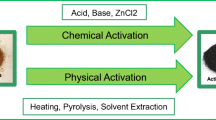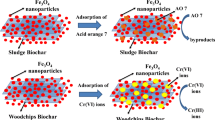Abstract
The floatability of different crystalline structures of pyrrhotite (monoclinic and hexagonal) was studied. It is shown that the floatability of monoclinic and hexagonal has obvious difference, and that the flotation recovery of monoclinic pyrrhotite is larger than that of hexagonal pyrrhotite using different collectors. When butyl dithiophosphate is used as the collector, the recovery is larger than that by sodium butyl xanthate and sodium diethyl dithiocarbamate. At the pH values ranging from 6 to 9, monoclinic pyrrhotite can be floated well, and the flotation recovery is higher than 90%. Monoclinic and hexagonal pyrrhotites are more easily activated by Cu2+ in acidic conditions than in alkaline conditions. But Cu2+ cannot activate hexagonal pyrrhotite using sodium diethyldithiocarbamate as the collector. By the measurement of contact angle, it is indicated that monoclinic and hexagonal pyrrhotites float well and are easily activated by Cu2+ when dithiophosphate is used as the collector. Using sodium diethyl dithiocarbamate as a collector, the relationship between potential and pH range for pyrrhotite flotation is established. At pH 5, the optimal potential range for flotation of monoclinic pyrrhotite is about 125–580 mV (vs SHE), with the maximum flotation occurring at about 350 mV (vs SHE); the optimal potential range for flotation of hexagonal pyrrhotite is 200–580 mV (vs SHE), with the maximum flotation occurring at about 300 mV (vs SHE).
Similar content being viewed by others
References
WARD J C. The structure and properties of some iron sulphides [J]. Rev Pure and Appl Chem, 1970, 20: 175–206.
ARNOLD R G. Range in composition and structure of 82 natural terrestrial pyrrhotites [J]. Can Miner, 1967, 9: 31–50.
JANZEN M P, NICHOLSON R V, SCHARER J M. Pyrrhotite reaction kinetics: Reaction rates for oxidation by oxygen, ferric iron, and for nonoxidative dissolution [J]. Geochimica et Cosmochimica Acta, 1999, 64(9): 1511–1522.
MILLER J D, LI A J, DAVIDTZ J C, VOS F. A review of pyrrhotite flotation chemistry in the processing of PGM ores [J]. Minerals Engineering, 2005, 18: 855–865.
ORLOVA T A, STUPNIKOV V M, KRESTAN A L. Mechanism of oxidative dissolution of sulphides [J]. Zhurnal Prikladnoi Khimii, 1988, 61: 2172–2177.
VANYUKOV A V, RAZUMOVSKAYA N N. Hydrothermal oxidation of pyrrhotites [J]. Izv Vyssh Uchelon Zaved, Tsvetn, Metall, 1979, 6: 605–610.
SUTHERLAND K L, WARK I W. The principles of flotation [M]. Australasian Institute of Mining and Metallurgy, 1955: 25–29.
YU Run-lan. Study on the basic theory of flotation electrochemistry of Pb-Sb-Fe-Zn sulfide minerals [D]. Changsha: University of Central South University, 2004: 78–87. (in Chinese)
HAMILTON I C, WOODS R. An investigation of surface oxidation of pyrite and pyrrhotite by linear potential sweep voltammetry [J]. J Electrochem, 1981, 118: 327–343.
ZHANG Qin. The study of electrochemistry flotation behavior and surface adsorption of lead-antimony-zinc-iron sulfides [D]. Changsha: University of Central South University, 2004: 62–72. (in Chinese)
PRESTIDGE C A, RALSTON J. Contact angle studies of particulate sulfide minerals [J]. Minerals Engineering, 1996, 9: 85–102.
PRESTIDGE C A, RALSTON J. Contact angle studies of galena particles [J]. Journal of Colloid and Interface Science, 1995, 172: 302–310.
CRAWFORD R, RALSTON J. The influence of particle size and contact angle in mineral flotation [J]. International Journal of Mineral Processing, 1988, 23: 1–24.
DIGGINS D, FOKKINK L K J, RALSTON J J. The wetting of angular quartz particles: Capillary pressure and contact angles [J]. Colloids and Surfaces, 1990, 44: 299–313.
BUSWELL A M, NICOL M J. Some aspects of the electrochemistry of the flotation of pyrrhotite [J]. Journal of Applied Science, 2002, 32: 1321–1329.
CHEN Jian-hua, LI Yu-qiong, CHEN Ye. Cu-S flotation separation via the combination of sodium humate and lime in a low pH medium [J]. Minerals Engineering, 2011, 24: 58–63.
Author information
Authors and Affiliations
Corresponding author
Additional information
Foundation item: Project(50774094) supported by the National Natural Science Foundation of China
Rights and permissions
About this article
Cite this article
He, Mf., Qin, Wq., Li, Wz. et al. Flotation performances of polymorphic pyrrhotite. J. Cent. South Univ. Technol. 19, 238–243 (2012). https://doi.org/10.1007/s11771-012-0997-2
Received:
Accepted:
Published:
Issue Date:
DOI: https://doi.org/10.1007/s11771-012-0997-2




